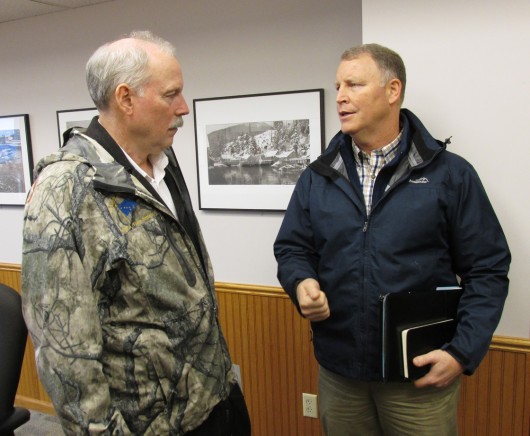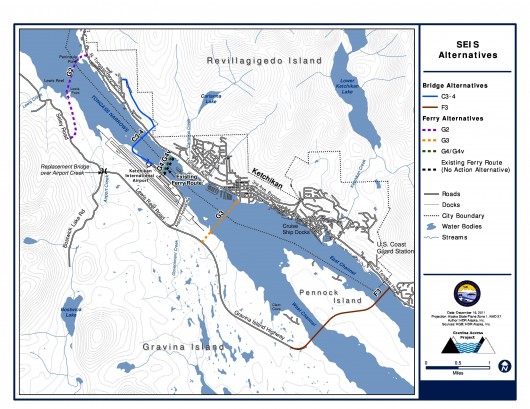
Sen. Bert Stedman, R-Sitka, and Alaska DOT Commissioner Marc Luiken talk at Ketchikan City Hall on Thursday. (Photo by Leila Kheiry)
The Gravina Island Access Supplemental Environmental Impact Statement process has moved forward now that the State of Alaska has chosen its preferred alternative, but Ketchikan officials were not excited about the choice
There was a meeting Thursday morning between Alaska’s Department of Transportation commissioner, Sen. Bert Stedman and Ketchikan borough and city officials, where DOT officials announced their choice of improved ferry service for Gravina.
The Gravina access project became nationally infamous during the buildup to the 2008 election when then-Gov. Sarah Palin redirected federal funding for the project, and made Ketchikan’s “Bridge to Nowhere” part of her vice-presidential campaign stump speech.
Seven years later, most Ketchikan officials still want that bridge. But pretty much everyone understands that, at this point, a bridge is off the table.
So, it wasn’t a surprise when DOT Commissioner Marc Luiken told a group of about a dozen state and Ketchikan officials that the department’s preferred alternative for the Gravina Access Improvement Project was improved ferry service.
“And that alternative is called G4-V,” he said.
Except for doing nothing, that alternative is the cheapest one, estimated to cost about $23 million. It includes a passenger waiting facility, shuttle vans, a heavy freight dock, new ferry transfer bridges, upgraded sidewalks and ramps, and replacement of the ferry layup dock.
It would not include new ferries or additional ferry service unless demand increased.
“Right now, based on our traffic projections that have come through the EIS, we don’t see that demand increasing, at least, certainly not in the immediate future and maybe not in the distant future,” Luiken said. “But, we will address that when we get to that point.”
Borough Manager Dan Bockhorst thanked Luiken and Southcoast Region Director Mike Coffey for traveling to Ketchikan for a face-to-face meeting with local officials. But, Bockhorst pointed out some concerns that the borough has with Alternative G4-V, particularly with items that will add costs to the borough, which operates the state-owned Ketchikan International Airport.
For example, the community would have to figure out how to pay for a new ferry when the current ones need replacement, and then there’s the shuttle vans.
“The solution in G4-V is to buy two econo-line vans and let the Ketchikan Gateway Borough operate them at a cost of $350,000 a year, which is throwing an anchor to us while we’re treading water,” Bockhorst said.
Bockhorst offered an alternate proposal for DOT to consider. That proposal includes more parking on the main island, an additional ferry transfer facility on each side so that service isn’t interrupted for maintenance, a new ferry and a satellite airport terminal on the Revilla Island side.
“So that people can put their baggage there, they can check in there and we can convey the baggage over there and people won’t have to worry about it,” he said.
Bockhorst said that would help solve issues that the proposed shuttle vans were to address, namely helping seniors and people with disabilities who otherwise would have trouble getting themselves and their luggage over on the ferry.
The entire borough proposal totals $96 million, which is the amount Bockhorst said should be left in the overall project account. But, Luiken said, the amount is really about $88 million.
And of that, he said, only $10 million is reserved for Gravina Access. The rest could be spent on any other Alaska DOT project that’s approved by the Federal Highway Administration.
Luiken warned Bockhorst and the others in the meeting that adding the borough’s proposal for consideration could delay the process further. He suggests that the borough support the preferred alternative as it is, and save discussion of the borough’s project list for a later time.
Sen. Bert Stedman of Sitka, who represents most of Southeast including Ketchikan, said the borough’s proposal is reasonable and should be considered. He adds that closing out the EIS process without first trying to include the borough’s ideas would make it more challenging to implement those projects later on, because the political leverage would be lost.
“If you allow that to happen and let that EIS window close, then it becomes basically a request for some other projects that every other community is going to request, especially if they know there’s $30 million of $50 million on the table,” he said.
Luiken said the administration wants to make sure that any flexible funding left after a Gravina Access choice has been finalized is spent in the region. Whether that’s the DOT Southcoast Region in general or the region closer to Ketchikan is not yet clear, and Luiken said he’ll clarify that with Gov. Bill Walker’s office.
The Southcoast region covers Southeast Alaska, plus Kodiak, the Alaska Peninsula, Aleutian Chain and Pribilof Islands.
As the hour-long meeting wrapped up, Borough Mayor David Landis asked Luiken to work cooperatively with the community to make sure the project is done correctly.
“So many times, government is criticized for inefficiencies, wastefulness, bad planning,” he said. “We have a unique opportunity right now to make sure that kind of thing doesn’t happen here and we don’t end up with having a white elephant, with a bus system that costs us more to operate. I would urge you to consider that and to get feedback from us on this.”
Luiken ended the meeting with a promise to take the borough’s suggestions back to the department, to determine what it would take – time and money – to implement some or all of those ideas.






